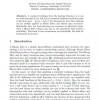Free Online Productivity Tools
i2Speak
i2Symbol
i2OCR
iTex2Img
iWeb2Print
iWeb2Shot
i2Type
iPdf2Split
iPdf2Merge
i2Bopomofo
i2Arabic
i2Style
i2Image
i2PDF
iLatex2Rtf
Sci2ools
ESA
2006
Springer
2006
Springer
Less Hashing, Same Performance: Building a Better Bloom Filter
A standard technique from the hashing literature is to use two hash functions h1(x) and h2(x) to simulate additional hash functions of the form gi(x) = h1(x) + ih2(x). We demonstrate that this technique can be usefully applied to Bloom filters and related data structures. Specifically, only two hash functions are necessary to effectively implement a Bloom filter without any loss in the asymptotic false positive probability. This leads to less computation and potentially less need for randomness in practice.
| Added | 22 Aug 2010 |
| Updated | 22 Aug 2010 |
| Type | Conference |
| Year | 2006 |
| Where | ESA |
| Authors | Adam Kirsch, Michael Mitzenmacher |
Comments (0)

